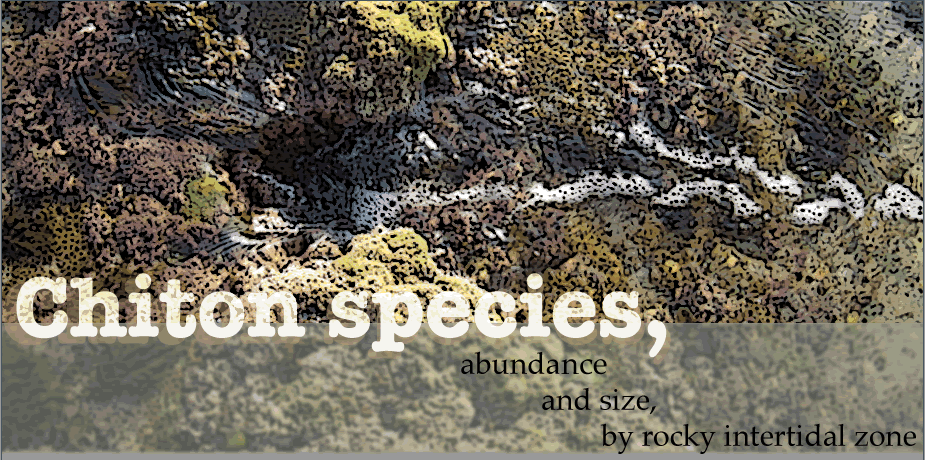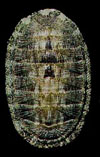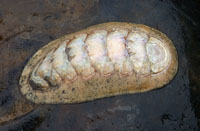 |
||||||||
 |
||||||||
|
After the experiment was conducted the total sample size was 38 (n=38) chiton across four species of chiton (table I). Although the initial intent of this experiment was to determine chiton rock preference (coqunia or basalt), chitons were found exclusively on coqunia rocks (n=38) see figure III. Due to this discovery chiton abundance, species, and size differences were analyzed among rocky intertidal zones. On average chitons tended tworads a central tidal distribution, in which zone III was the most heavily populated zone (see figure I). Chiton species were most diverse and largest in zone III (see figure II, figure IV, and figure V). Variations in species trends can only be observed for three species of chitons. Not enough data was collected for the heath's chiton (n=1). Relationships among chiton size, chiton abundance and rock size were found. On smaller rocks more chitons were found, and on larger rocks fewer chitons were found. Hence, there was an inversely proportional relationship (see figure VI). Finally, the average length of chitons increased with rock size (see figure VII). Four species of chiton were identified in this study at Station Beach, Puerto, Penasco:  Brown Chiton (Chiton articulatus)* Brown Chiton (Chiton articulatus)*
 Black Chiton (Chiton stokesii)* Black Chiton (Chiton stokesii)*
 Green Striped Chiton (Chiton virgulatus)* Green Striped Chiton (Chiton virgulatus)*
 Heath's Chiton (Stenoplax heathiana)** Heath's Chiton (Stenoplax heathiana)**
*(Kaas, et al 2006), **(Burghardt, 1969) Figures and Table: Figure I. 
On average, more chitons, across all species (with the exception of Heath's Chiton due to low sample size), were found per basalt rock in lower and middle Zone III. Figure II. 
Chitons, across all species (with the exception of Heath's chiton due to low sample size) were largest in lower Zone III and high Zone IV. Figure III. 
Chitons of all species were found exclusively on coquina rocks (coqunia, n=38 and basalt, n=14). Figure IV. 
Low Zone III also contained the most chiton species. Green striped chiton (Chiton virgulatus) was the most prevalent species and was the most dominant species throughout high and low Zone III. Figure V.  Black and green striped chitons were found in low Zone III. One brown chiton was found in Zone IV. Striped chitons were found in middle Zone II.
Black and green striped chitons were found in low Zone III. One brown chiton was found in Zone IV. Striped chitons were found in middle Zone II.
Figure VI 
Rock size and abundance of chitons per rock were inversely proportional. (R squared= 0.0702) Figure VII 
There was a positive relationship between length of chitons and rock size. (R squarde= -0.8275) Table I. Table of raw data 
Works Cited   |
||||||||